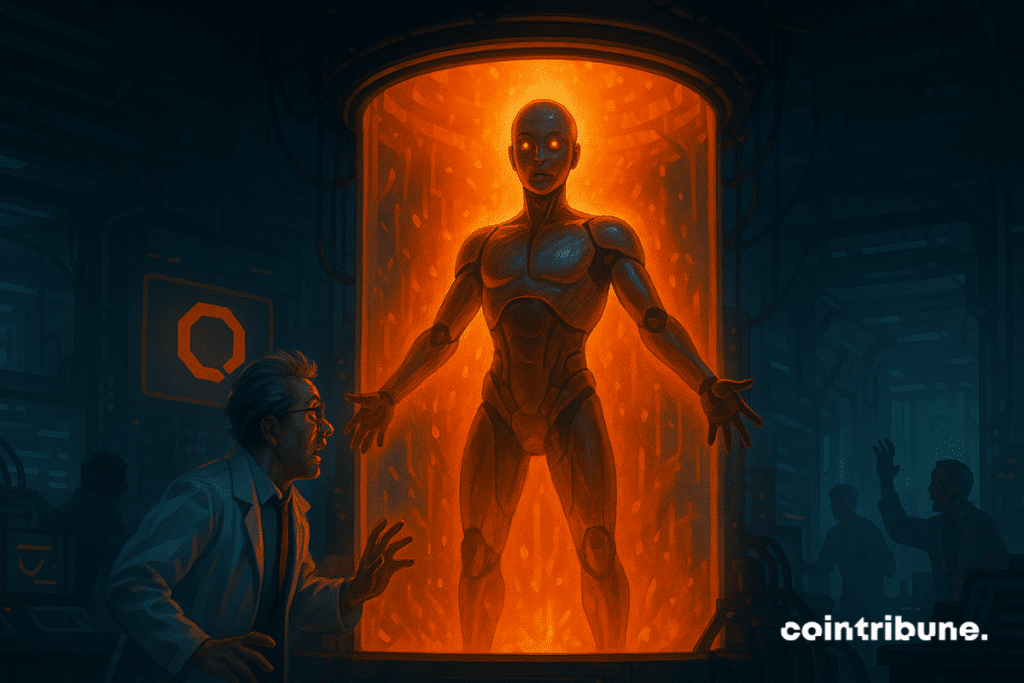Qubic: AGI (scientist paper)
Deep learning labs showcase models with a trillion parameters and mountains of GPUs, but each new breakthrough always demands more electricity and money. The Aigarth project from Qubic poses a provocative question: what if the road to artificial general intelligence (AGI) did not go through ever larger data centers, but through millions of ordinary CPUs working together and evolving by themselves?

In brief
- Brains over brute force: Evolves millions of tiny ternary‑logic “neural scraps” on spare CPUs; the fittest survive each week on‑chain.
- Science bench: AGI pioneer David Vivancos and neuroscientist Dr José Sánchez García lead the project (since July 2024).
- Efficient & open: Ternary (+1/0/–1) nets slash power use (~‑70 %) and run on any multi‑core laptop, no GPU gatekeepers.
- Next step: Winning agents will live as self‑funded smart contracts, building a planet‑wide “coral reef” of evolving machine minds on Qubic.
David Vivancos
David Vivancos is a Spanish scientist specialized in artificial intelligence and a tech entrepreneur active since 1995. He is currently scientific advisor in general artificial intelligence (AGI) for the Qubic blockchain project (appointed July 29, 2024) and founder-director of MindBigData, the largest open EEG repository worldwide, behind benchmarks such as the “MNIST of Brain Digits” (2015) and the “MNIST-8B” version with 8 billion samples (2023).
Over three decades, he has founded five startups covering early web services, virtual/augmented reality, nanotechnology, 3D printing, and AI. He currently sits on the board of the Barcelona consulting firm Keenfolks. His public work includes 400+ talks for companies, universities, and forums such as AI for Good by the ITU and the ICLR 2025 conference.
Vivancos has amassed 25,000 hours of R&D in the quest for AGI and brain-computer interfaces, combining deep learning methods and massive sets of neural signals.
He is the author of four books on the societal impact of technology (The End of Knowledge 2024; Automate or Be Automated 2020; From Big Data to Artificial Intelligence 2016/2019) and regularly publishes articles on AGI and blockchain.
His personal motto, “Teaching Machines, Advising Humans, Exploring Brains“, illustrates a career spent both advancing machine intelligence and guiding organizations in their digital transformation.
Dr. José Sánchez García
Dr. José Sánchez García is a neuroscientist, biotechnologist, and former Spanish industrial engineer whose career bridges engineering, life sciences, and psychology.
Since July 2024, he has been on the Qubic scientific advisory board, guiding its AGI roadmap, while teaching behavioral and cognitive neuroscience at the International University of La Rioja (UNIR). He holds a PhD in psychology / cognitive neuroscience from Complutense University of Madrid.
Over the past decade, he has published 20+ Q1/Q2 scientific articles on social emotions, decision-making, default mode network, and resting brain dynamics.
Outside academia, he is a behavioral science consultant for organizations ranging from the Saudi Football Federation to blockchain startups, helping translate neuroscientific knowledge into performance and human factors strategies — notably for Qubic’s Aigarth initiative.
Aigarth in one paragraph
Aigarth views AGI not as a monolithic “super-model” but as a living garden of tiny neural fragments — an intelligent tissue — evolving through natural selection.
Each fragment is encoded in ternary logic (TRUE, FALSE, UNKNOWN) rather than binary, learns on cheap CPUs instead of expensive GPUs, and competes weekly within Qubic’s decentralized network.
The best survive; others are eliminated. Over time, the tissue should self-organize into ever smarter agents, all secured and audited by the Qubic blockchain.
How this differs from current AI
| Feature | Classic Deep Learning (GPU) | Aigarth (CPU) |
|---|---|---|
| Hardware | GPU farms, reserved for a few mega-labs | Standard CPUs, accessible to all |
| Logic | Binary weights (0/1 or ±1) | Ternary weights (+1, 0, –1) introducing the “unknown” state |
| Growth | Manually defined scale | Darwinian evolution of the intelligent tissue |
| Evaluation | Loss function on a fixed dataset | Weekly automatic score via reconstruction game |
| Governance | Enterprise servers | Smart contracts on Qubic L1 |
| Supply chain | GPU shortage, energy costs | CPU cycles available everywhere |
How the pieces fit together
- Intelligent tissue
Imagine an ultra-sparse autoencoder where neurons update one by one.
Each weight is deterministically generated from the miner’s public key and a nonce, ensuring reproducibility while maintaining an astronomical search space. - Ternary computing
By allowing a third “unknown” value, the system explicitly represents noise or ambiguity, reducing energy consumption by up to 70% in hardware prototypes. - Weekly evolution loop
- Mutation: inversion of some neuronal states.
- Crossover: mixing two best candidates to generate offspring.
- Adaptive threshold: eliminates losers and raises the requirement level for the next epoch.
- Deterministic evaluation
A ternary pattern is sent into the tissue; after a series of asynchronous updates, the output neurons restoring the input are counted.
If the score exceeds the epoch’s dynamic threshold, the candidate advances to the next round. - On-chain settlement
Each experiment is hashed and timestamped on Qubic.
In the future, winning agents will deploy themselves as smart contracts, becoming autonomous AI modules capable of living, earning, and spending on-chain.
Why CPUs rather than GPUs?
- Accessibility: GPU clusters belong to a few giants; CPUs are everywhere.
- Evolution speed: Millions of small cheap trials beat one huge and costly test.
- Energy footprint: Sparse ternary networks + AVX-accelerated integer calculations learn more per joule than floating-point giants.
Potential benefits
When functional AGI emerges, everyday life will shift towards the era of the “universal copilot.”
Imagine: instant medical diagnostics via your phone; personalized education adapting in real-time; buildings optimizing their own energy consumption; scientific discoveries accelerated by intelligences testing millions of hypotheses per hour; political decisions supported by global simulations rather than crude approximations.
AGI would not just automate tasks: it would amplify creativity and problem-solving on a scale we cannot yet imagine. Provided we set solid ethical safeguards now so it serves humanity rather than overshadowing it.
And then?
The team plans to regularly publish epoch reports, open benchmarks, and ultimately release AIs capable of renting their own computing power on Qubic, thanks to its fee-free network and 15 million TPS.
If realized, the road to AGI will look less like a giant data center and more like a massive planetary coral reef of evolving minds.
For now, Aigarth offers a new hypothesis: general intelligence might emerge not from bigger GPUs, but from better evolution.
Scientific article: (PDF) Qubic AGI Journey Human and Artificial Intelligence: Toward an AGI with Aigarth
Educational content, not financial advice. Always do your own research.

Maximize your Cointribune experience with our "Read to Earn" program! For every article you read, earn points and access exclusive rewards. Sign up now and start earning benefits.
The Cointribune editorial team unites its voices to address topics related to cryptocurrencies, investment, the metaverse, and NFTs, while striving to answer your questions as best as possible.
The contents and products mentioned on this page are in no way approved by Cointribune and should not be interpreted as falling under its responsibility.
Cointribune strives to communicate all useful information to readers, but cannot guarantee its accuracy and completeness. We invite readers to do their research before taking any action related to the company and to take full responsibility for their decisions. This article should not be considered as investment advice, an offer, or an invitation to purchase any products or services.
Investment in digital financial assets carries risks.
Read more